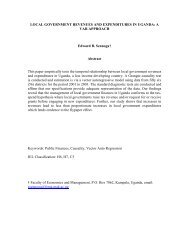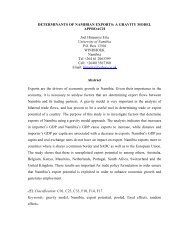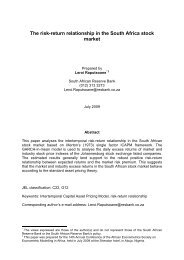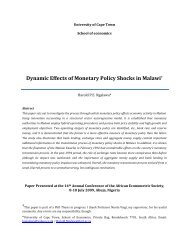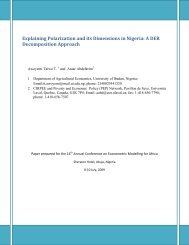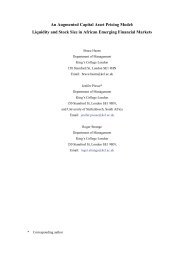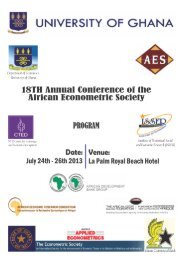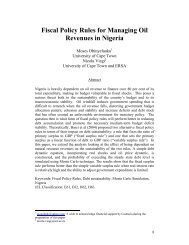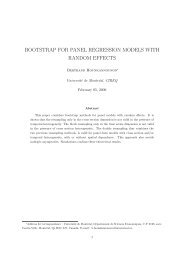The Foreign Exchange Rates in Nigeria - African Econometric Society
The Foreign Exchange Rates in Nigeria - African Econometric Society
The Foreign Exchange Rates in Nigeria - African Econometric Society
You also want an ePaper? Increase the reach of your titles
YUMPU automatically turns print PDFs into web optimized ePapers that Google loves.
Auwal and HamzatIf we know where the surplus function starts from i.e S i (vp ),itmechanisms and design have the same expected revenue.follows that all auctionFew empirical studies have attempted to validate theoretical models of auction <strong>in</strong> Sub-SaharanAfrica Aron and Elbadewi (1994b). Most empirical works only test the implication of the theorythrough the reduced-form model. For <strong>in</strong>stance , they try to expla<strong>in</strong> bids <strong>in</strong> term of a reserve price,the number of potential bidders, characteristics of the auctioned object which affect the commondistribution of private values (eg. Hasen 1985;Hendricks and Porter ,1988) .Adamgbe’s(2006)work on RDAS assume that Efficient Market Hypothesis(EMH) holds <strong>in</strong>the foreign exchange market .His works showed that RDAS has brought about relative stability<strong>in</strong> the exchange rate <strong>in</strong> the forex market <strong>in</strong> <strong>Nigeria</strong>. This work was <strong>in</strong>terested <strong>in</strong> a shortrunrelationship between exchange rate under RDAS and other variables. So the author used VAR tomodel exchange rate on <strong>in</strong>flation rate and lend<strong>in</strong>g rate. His conclusion can therefore not beapplicable to a long term period<strong>The</strong> important variables to the theoretical analysis of auction system are foreign exchangedemand, supply and opportunity cost (i.e parallel market rate). Empirical f<strong>in</strong>d<strong>in</strong>gs havecorroborated the suggestion of the theory of auction given these variables Aron and Elbadewi,1994a) cited <strong>in</strong> Auwal(2009). <strong>The</strong>ir f<strong>in</strong>d<strong>in</strong>gs show that <strong>in</strong>creased supply of foreign exchangebr<strong>in</strong>g about appreciation of local currency and <strong>in</strong>creased demand for foreign exchange causesdevaluation of local currency. Aron and Elbadewi (1994a) cited <strong>in</strong> Auwal(2009)also found that<strong>in</strong>creased number of bidders lead to equilibrium auction rate depreciation <strong>in</strong> <strong>Nigeria</strong>.4.0 Methodology4.1 Nature and Sources of Data.<strong>The</strong> data for this study are sourced from CBN’s website and its 2006 Statistical Bullet<strong>in</strong>. 2000 to2008 is the period covered. Inter Bank <strong>Foreign</strong> <strong>Exchange</strong> Market (IFEM) was operative between1999 to July 2002 <strong>in</strong> <strong>Nigeria</strong> and the Dutch Auction System was operative between 2000 to2008. <strong>The</strong> study therefore make use of both foreign exchange rates and quantity traded dur<strong>in</strong>gthese two allocation market arrangement.7



